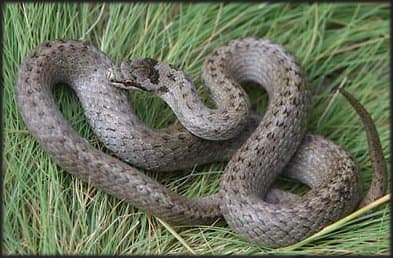Smooth Snake Fact File
The
Smooth snake fact file
Smooth Snake
- Common name – smooth snake
- Scientific name – coronella austriaca
- Size – a typical adult will be between 40 and 60cm long
- Identification tips – body colour varies between silvery-grey and a gingery-brown, with a mottled black pattern running the entire length of the body. At first glance, smooth snakes can be confused with adders because of this, but a smooth snake has a more slender build. The top of the head is often a darker shade to the body, and a black stripe running across each eye is often present.
- Preferred habitat – light, sandy heathlands are the preferred choice but smooth snakes will also readily live in areas of dense undergrowth.
- Diet – surprisingly, smooth snakes prey primarily on other snakes and lizards. The rare sand lizard is a favourite, particularly because they share the same habitat. Small mammals, rodents and baby birds are also taken, as are larger insect and frogs. A smooth snake has no venom, but strikes its prey and then subdues it by wrapping its body tightly around the prey before consumption.
- Breeding – mating occurs in late spring, around May, and give birth to up to 15 young in late August/September.
- Other points – smooth snakes are extremely secretive and spend a large proportion of their lives in sandy burrows just beneath the surface. For this reason, it’s very rare to see one – even in habitats where they are known to exist.
The sandy heathlands of the New Forest are an ideal habitat for them, and one of only several places in the UK that they can be found.
Related Pages:

New Forest Getaway
The New Forest in southern England is unlike anywhere else, one moment you’re on a country lane, the next you’re face to face with a pony blocking traffic. Villages with thatched roofs appear out of

How Satellite Imagery is Transforming Wildlife Conservation
Today, a myriad of species and their habitats are struggling to survive and are on the verge of extinction due to permanent pressure on deforestation, climate change, and unlawful activities like illegal mining and logging.

The Role Of Satellite Technology In Monitoring
The oceans are a cornerstone of life on Earth, housing a vast array of creatures that play critical roles in sustaining ecosystems and supporting humanity. From vibrant coral reefs to expansive kelp forests, marine life

5 Digital Detox Lessons to Take From New Forest Getaway Back into Daily Life
Do you remember when there were only a handful of channels on television? We can. It was a simple life back then, less frantic, and that meant there was a clear line between watching TV

How Forest Play Can Teach Your Dog Better Greetings
Dogs have a special way of saying hello—usually with airborne paws, flying tongues, and an Olympic-level leap into your personal space. It might be endearing to strangers once or twice, but when muddy paw prints

How To Make Traveling Less Stressful
How to Make Travelling Less Stressful Travel should refresh and inspire you—not leave you feeling frazzled and drained. Unfortunately, missed connections, overloaded itineraries, and overstuffed suitcases can turn even the most exciting holiday into a

